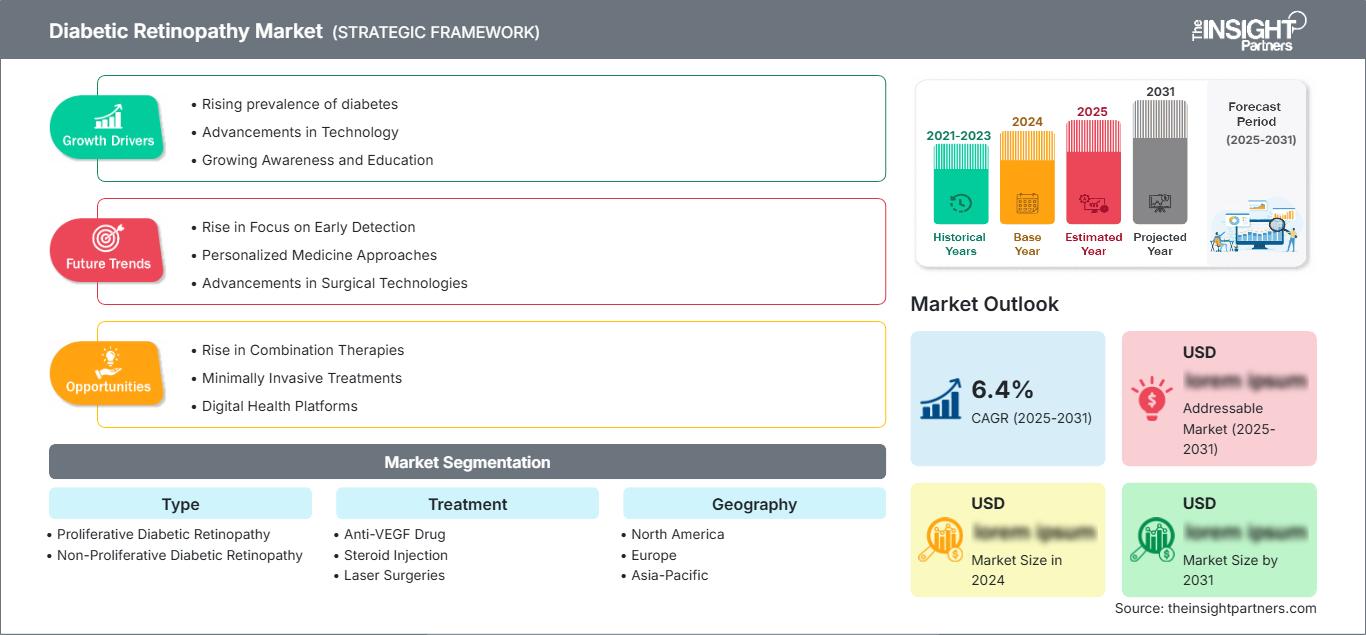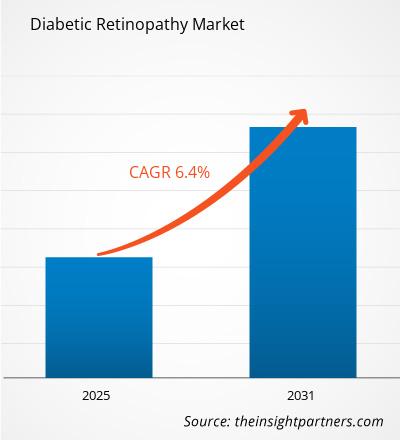Se espera que el tamaño del mercado de la retinopatía diabética alcance los 17.340 millones de dólares estadounidenses para 2031. Se anticipa que el mercado registre una CAGR del 6,5 % durante 2025-2031.
El informe está segmentado por tipo (retinopatía diabética proliferativa y retinopatía diabética no proliferativa) y tratamiento (fármacos anti-VEGF, inyecciones de esteroides, cirugías láser y vitrectomía). Además, presenta un análisis basado en el canal de distribución (farmacias minoristas, farmacias hospitalarias y otros). El análisis global se desglosa a nivel regional y por países principales. El informe ofrece el valor en USD para el análisis y los segmentos mencionados.
Propósito del Informe
El informe "Mercado de Retinopatía Diabética" de The Insight Partners busca describir el panorama actual y el crecimiento futuro, los principales factores impulsores, los desafíos y las oportunidades. Esto proporcionará información a diversas partes interesadas del negocio, como:
- Proveedores/fabricantes de tecnología: Para comprender la dinámica cambiante del mercado y conocer las oportunidades potenciales de crecimiento, lo que les permitirá tomar decisiones estratégicas informadas.
- Inversores: Realizar un análisis exhaustivo de tendencias respecto a la tasa de crecimiento del mercado, las proyecciones financieras del mercado y las oportunidades que existen en toda la cadena de valor.
- Órganos reguladores: Regular las políticas y las actividades policiales en el mercado con el objetivo de minimizar el abuso, preservar la confianza de los inversores y defender la integridad y estabilidad del mercado.
Segmentación del mercado de la retinopatía diabética
- Retinopatía diabética proliferativa
- Retinopatía diabética no proliferativa
Tratamiento
- Fármaco anti-VEGF
- Inyección de esteroides
- Cirugías láser
- Vitrectomía
Obtendrá personalización en cualquier informe, sin cargo, incluidas partes de este informe o análisis a nivel de país, paquete de datos de Excel, así como también grandes ofertas y descuentos para empresas emergentes y universidades.
Mercado de la retinopatía diabética: perspectivas estratégicas

-
Obtenga las principales tendencias clave del mercado de este informe.Esta muestra GRATUITA incluirá análisis de datos, desde tendencias del mercado hasta estimaciones y pronósticos.
Factores que impulsan el crecimiento del mercado de la retinopatía diabética
- Aumento de la prevalencia de la diabetes: Según la Federación Internacional de Diabetes, se estima que 642 millones de personas padecerán diabetes en todo el mundo para 2040, lo que incrementa la demanda de tratamientos para la retinopatía diabética. El creciente número de casos prevalentes de diabetes es uno de los principales impulsores de este crecimiento, ya que la retinopatía diabética suele ser consecuencia de complicaciones de la enfermedad.
- Avances tecnológicos: Los avances tecnológicos, como la inteligencia artificial, el aprendizaje automático y otros, permitirán el desarrollo de herramientas de diagnóstico cada vez más precisas y eficientes para la retinopatía diabética. Avances en las opciones de tratamiento para el paciente: Los avances tecnológicos también mejoran las opciones de tratamiento para el paciente con retinopatía diabética.
- Concienciación y educación crecientes: La creciente concienciación y educación de todas las personas sobre la necesidad de exámenes oculares regulares y el diagnóstico temprano de la retinopatía diabética está impulsando la demanda de tratamientos y servicios para la retinopatía diabética. La Asociación Americana de la Diabetes recomienda un examen ocular completo anual realizado por un oftalmólogo a los pacientes con diabetes. Actualmente, la mayoría de los servicios de salud están intentando aumentar...
Tendencias futuras del mercado de la retinopatía diabética
- Aumento del enfoque en la detección temprana: La atención a la detección temprana de la retinopatía diabética ha aumentado gracias a los grandes avances tecnológicos y a la creciente concienciación sobre su importancia. La telemedicina y las aplicaciones móviles de salud hacen posible la monitorización remota y la detección temprana de la retinopatía diabética. Esto contribuye a mejorar los resultados de los pacientes con menores costes sanitarios.
- Enfoques de medicina personalizada: La medicina personalizada y de precisión se utilizan cada vez más para el tratamiento de la retinopatía diabética. Diversos profesionales de la salud prescriben tratamientos personalizados, basados en la composición genética del paciente y la naturaleza de su enfermedad, para obtener mejores resultados y un menor costo del tratamiento.
- Avances en tecnologías quirúrgicas: Las tecnologías quirúrgicas mejoradas, como la cirugía microincisional o la cirugía de cataratas asistida por láser de femtosegundo, tienen el potencial de mejorar los resultados del paciente y los tiempos de recuperación. Desarrollos como estos deberían impulsar el crecimiento del mercado, en particular por los ahorros y las mejoras en la atención al paciente que se derivan de ellos.
Oportunidades de mercado para la retinopatía diabética
- Aumento de las terapias combinadas: La incorporación de terapias combinadas centradas en diversas vías implicadas en la retinopatía diabética está abriendo nuevas vías en el tratamiento de la enfermedad. Se supone que las terapias combinadas son más eficaces que las terapias con un solo agente. Es probable que esto se traduzca en mejores resultados para los pacientes y menores costos de tratamiento.
- Tratamientos mínimamente invasivos: Los tratamientos mínimamente invasivos, como las inyecciones intravítreas y la fotocoagulación, se están desarrollando y abriendo nuevas vías en el tratamiento de la retinopatía diabética. Los tratamientos mínimamente invasivos son mucho más minimalistas que las técnicas quirúrgicas clásicas, por lo que se basan en minimizar el riesgo para el paciente y acelerar la recuperación.
- Plataformas de salud digital: Las plataformas de salud digital, como la telemedicina y las aplicaciones móviles, han facilitado el manejo a distancia de la retinopatía diabética. Estas plataformas pueden optimizar la participación del paciente y la adherencia a los planes de atención, reduciendo así los costos de atención médica y mejorando los resultados.
Perspectivas regionales del mercado de la retinopatía diabética
Los analistas de The Insight Partners han explicado detalladamente las tendencias regionales y los factores que influyen en el mercado de la retinopatía diabética durante el período de pronóstico. Esta sección también analiza los segmentos y la geografía del mercado de la retinopatía diabética en América del Norte, Europa, Asia Pacífico, Oriente Medio y África, y América del Sur y Central.
Alcance del informe de mercado sobre la retinopatía diabética
| Atributo del informe | Detalles |
|---|---|
| Tamaño del mercado en 2024 | XX mil millones de dólares estadounidenses |
| Tamaño del mercado en 2031 | 17.340 millones de dólares estadounidenses |
| CAGR global (2025-2031) | 6,5% |
| Datos históricos | 2021-2023 |
| Período de pronóstico | 2025-2031 |
| Segmentos cubiertos |
Por tipo
|
| Regiones y países cubiertos |
América del norte
|
| Líderes del mercado y perfiles de empresas clave |
|
Densidad de actores del mercado de la retinopatía diabética: comprensión de su impacto en la dinámica empresarial
El mercado de la retinopatía diabética está creciendo rápidamente, impulsado por la creciente demanda del usuario final debido a factores como la evolución de las preferencias del consumidor, los avances tecnológicos y un mayor conocimiento de los beneficios del producto. A medida que aumenta la demanda, las empresas amplían su oferta, innovan para satisfacer las necesidades del consumidor y aprovechan las tendencias emergentes, lo que impulsa aún más el crecimiento del mercado.

- Obtenga una descripción general de los principales actores clave del mercado de la retinopatía diabética
Puntos clave de venta
- Cobertura integral: el informe cubre de manera integral el análisis de productos, servicios, tipos y usuarios finales del mercado de retinopatía diabética, proporcionando un panorama holístico.
- Análisis de expertos: el informe se compila con base en el conocimiento profundo de expertos y analistas de la industria.
- Información actualizada: El informe asegura relevancia comercial debido a su cobertura de información reciente y tendencias de datos.
- Opciones de personalización: este informe se puede personalizar para satisfacer los requisitos específicos del cliente y adaptarse adecuadamente a las estrategias comerciales.
Por lo tanto, el informe de investigación sobre el mercado de la retinopatía diabética puede ayudar a descifrar y comprender el panorama de la industria y sus perspectivas de crecimiento. Si bien existen algunas preocupaciones válidas, las ventajas generales de este informe suelen superar las desventajas.
- Análisis histórico (2 años), año base, pronóstico (7 años) con CAGR
- Análisis PEST y FODA
- Tamaño del mercado, valor/volumen: global, regional y nacional
- Industria y panorama competitivo
- Conjunto de datos de Excel
Informes recientes
Informes relacionados
Testimonios
Razón para comprar
- Toma de decisiones informada
- Comprensión de la dinámica del mercado
- Análisis competitivo
- Información sobre clientes
- Pronósticos del mercado
- Mitigación de riesgos
- Planificación estratégica
- Justificación de la inversión
- Identificación de mercados emergentes
- Mejora de las estrategias de marketing
- Impulso de la eficiencia operativa
- Alineación con las tendencias regulatorias






















 Obtenga una muestra gratuita para - Mercado de la retinopatía diabética
Obtenga una muestra gratuita para - Mercado de la retinopatía diabética